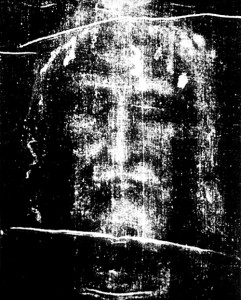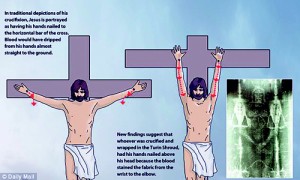Sunday Times 2
Was Jesus crucified with his arms above his head?
For centuries the Church has largely depicted the crucifixion of Christ with his arms outstretched horizontally on a cross.
But scientists believe that death by crucifixion may have been even crueller, and that a victim’s arms were probably nailed above their head.

The imprint on the Shroud (Reuters)
An international team studying the Shroud of Turin, which appears to depict a man who was put to death by crucifixion, said that no matter who created it, the artefact suggests that the practice involved a victim who was suspended in a Y-shape.
The Shroud of Turin is the most studied artefact in history and opinion is divided as to whether it was created in medieval times as a kind of hoax or whether it really shows the face of Jesus of Nazareth, as some believe.
Whatever the case, the linen cloth, which is imprinted with the faint image of a naked man, seems to show lines of blood that have streamed down his arms as well as other wounds.
Regardless of whether the Shroud is Biblical or medieval, Matteo Borrini at Liverpool John Moores University told New Scientist that ‘it’s a very interesting piece of art and human ingenuity’.
He set out to find whether the ‘bloodstains’ on the left arm matched up with the flow of blood from a crucified person.
To investigate, another researcher from the University of Pavia, Italy, assumed different crucifixion poses while donated blood trickled down his arm from a place where the shroud shows a nail was hammered through the hand.

Brutal: In the experiment, a researcher from the University of Pavia, Italy, assumed different crucifixion poses while donated blood trickled down his arm from a place where the Shroud shows a nail was hammered through the man's hand
The duo found that the ‘blood’ marks on the shroud correspond to a crucifixion – but only if a person was nailed onto a cross in a ‘Y’ position instead of a ‘T’ position, as depicted in most Christian art.
Dr Borrini said: ‘This would have been a very painful position and one which would have created difficulty breathing.’
It is thought that someone crucified in a ‘Y’ position would have died from asphyxiation.
He explained to a February meeting of the American Academy of Forensic Sciences in Seattle that similar positions were used in medieval torture, where victims were suspended from a beam from their wrists, which were tied with rope.
So if the Shroud is indeed a medieval forgery, it may be an interpretation of contemporary practice, rather than that of Biblical times.
The results of the experiment back up earlier work by a Massachusetts-based doctor called Gilbert Lavoie who suggested that the person depicted in the shroud was crucified in a Y-shape.
In his study, Dr Lavoie said: ‘The blood-flow is absolutely consistent with what you see on the Shroud.’
Danish doctor Niels Svensson, who has studied the Shroud, said: ‘The imprint on the Shroud does not correspond with many traditional artistic images of crucifixion.’
While the majority of Christian art shows Jesus stretched into a T-shaped position on the cross, some painters, including Peter Paul Rubens, depicted Christ with his arms above his head on the cross.
Dr Borrini believes that the person who made the shroud must have been a skilled forger (if it is not ‘real’) to show the correct blood spatter for a crucifixion – or they stumbled across it by chance.
‘It could be that the artist just decided to draw the rivulets of blood parallel to the arms for artistic reasons,’ he said.
©Daily Mail, London
| THE PAIN AND SUFFERING INFLICTED BY CRUCIFIXION
In Roman times there was a common way to put people on the cross, Matteo Borrini told MailOnline. ‘The vertical stake was fixed to the soil in an area usually devoted to capital punishments, while the horizontal branch, called the patibulum, was carried on by the person who was to be crucified.’ ‘Theoretically this was the rule, but Roman historian Josephus (Giuseppe Flavio) reported how in the war against Gerusalem in 70 AD,Roman soldiers enjoyed crucifying prisoners on trees in the most painful and strange positions.’ Dr Borrini explained that there are only short passages of writing from ancient authors about crucifixion, probably because the technique was a well-known way to sentence someone to death – ‘but it was also a very infamous way to die.’ Dr Frederick Zugibe conducted ‘extensive suspension studies’ that explained the higher the upper limbs are, more painful the ‘Y’ position is. ‘We have some reports of cruciarii (victim of crucifixion) that stayed on the cross for some days and this could be related to the use of the sedile,’ he said. WHAT IS THE TURiN SHROUD? The reason for the procedure was likely not merciful but designed to prolong the pain of the victim and their exposure to the sun, as well as their humiliation ‘partially starving him but also creating muscular pain to him due to the uncomfortable position of upper and lower limbs’. If authorities wanted the victim’s death to be quicker, they might have positioned them in a high ‘Y’ position and broken their legs, which would have increased breathing difficulty and accelerated death, Dr Borrini explained. |


